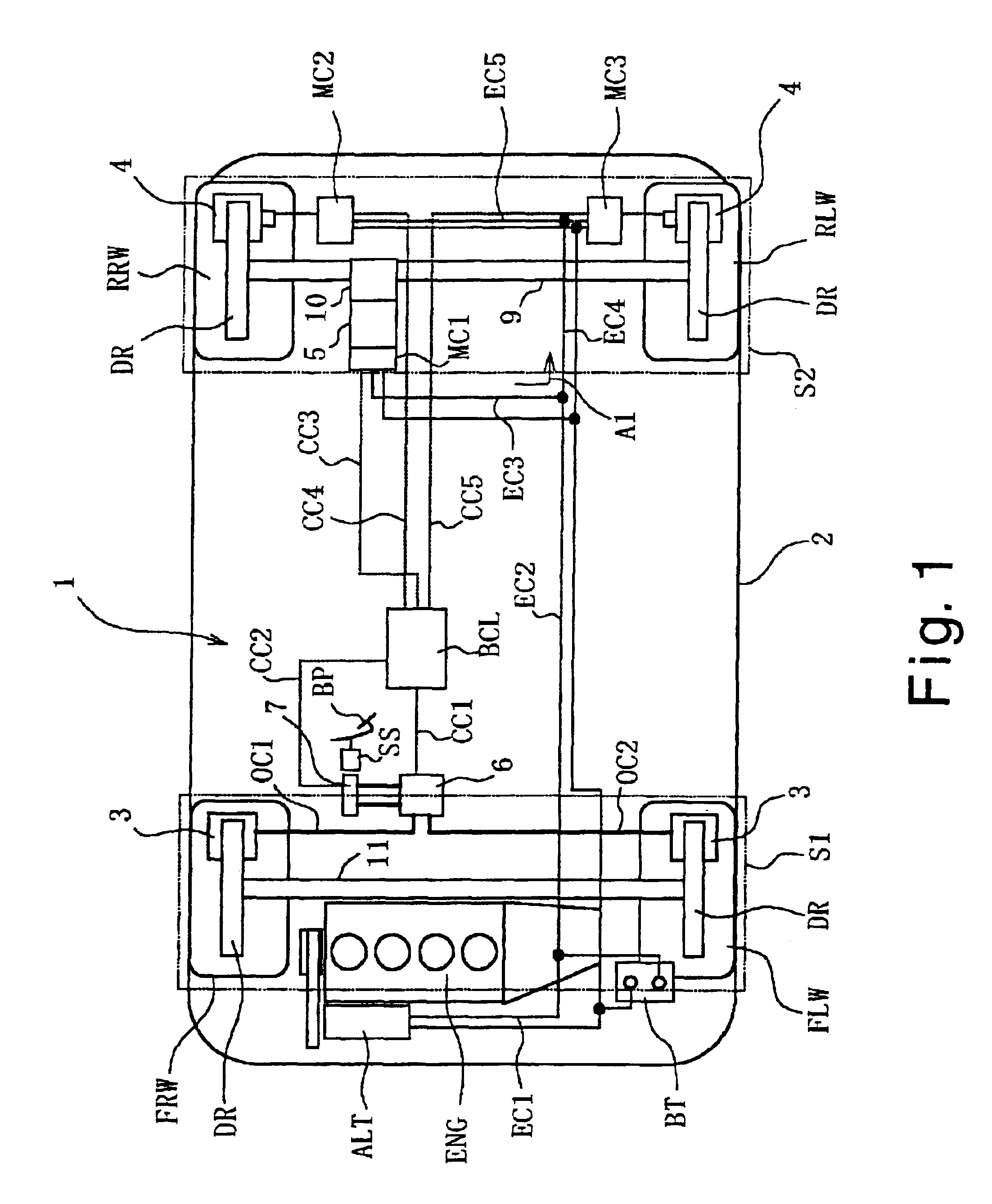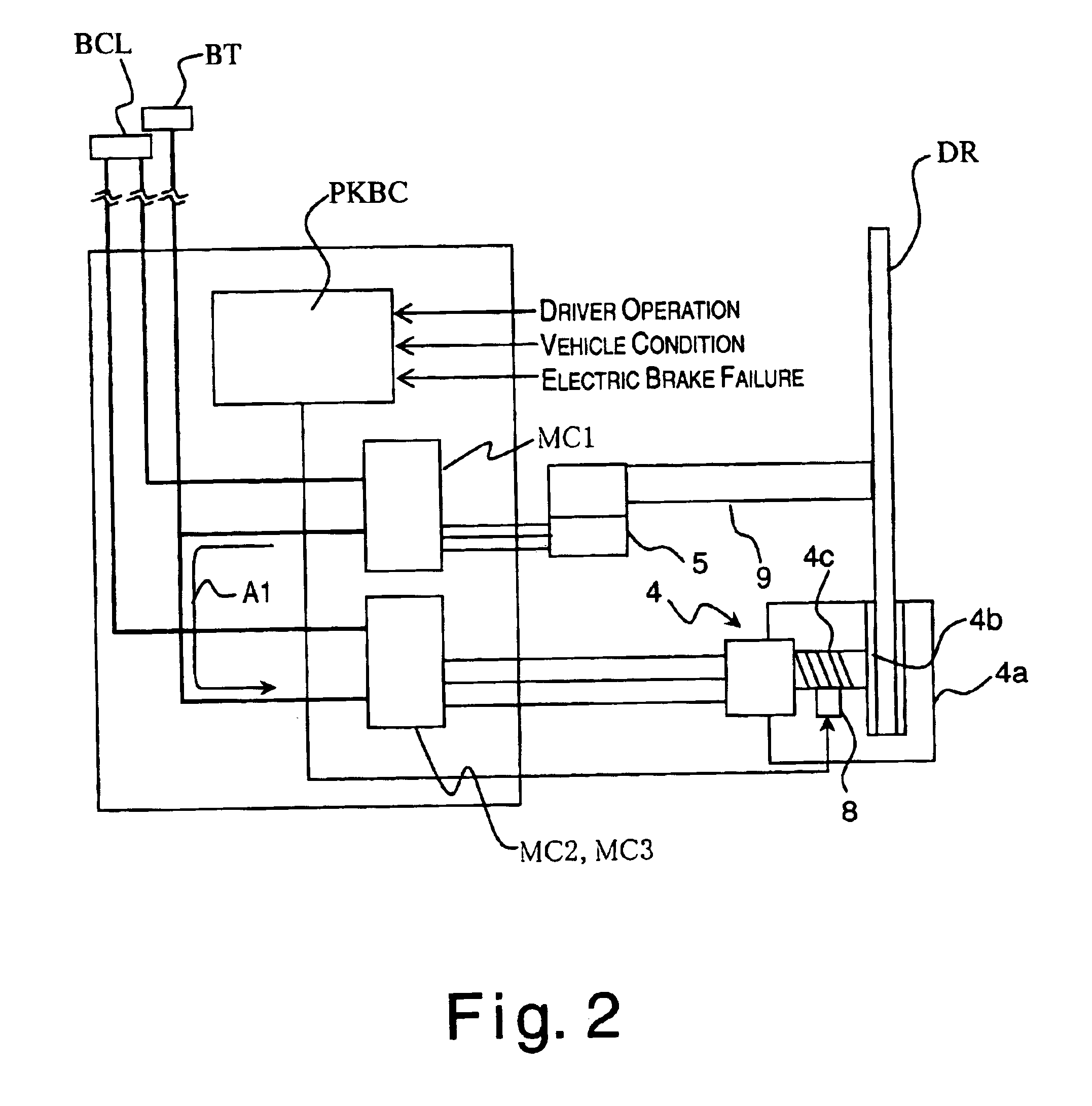Vehicle braking apparatus
a technology for braking apparatus and vehicles, which is applied in the direction of braking components, propulsion using engine-driven generators, electric devices, etc., can solve the problems of energy loss from battery charging and discharging, inability to use regenerated electric power for braking, and need for a larger battery to offset those energy losses. , to achieve the effect of reducing the size of the battery
- Summary
- Abstract
- Description
- Claims
- Application Information
AI Technical Summary
Benefits of technology
Problems solved by technology
Method used
Image
Examples
second embodiment
[0053]Referring now to FIGS. 3 and 4, a vehicle braking apparatus 21 in accordance with a second embodiment will now be explained. In view of the similarity between the first and second embodiments, the parts of the second embodiment that are identical to the parts of the first embodiment will be given the same reference numerals as the parts of the first embodiment. Thus, the descriptions of the parts of the second embodiment that are identical to the parts of the first embodiment may be omitted for the sake of brevity.
[0054]FIG. 3 is a system block diagram that shows the motor vehicle braking apparatus 21 according to the second embodiment of the vehicle braking apparatus of the present invention. The motor vehicle braking apparatus 1 of the first embodiment is constituted so that a single regenerative brake 5 in common with the right and left rear wheels RRW and RLW is linked to the differential gear 10. However, the motor vehicle braking apparatus 21 of the second embodiment is ...
third embodiment
[0061]Referring now to FIG. 5, a vehicle braking apparatus 31 in accordance with a third embodiment will now be explained. In view of the similarity between the third embodiment and the prior embodiments, the parts of the third embodiment that are identical to the parts of the prior embodiments will be given the same reference numerals as the parts of the prior embodiments. Moreover, the descriptions of the parts of the third embodiment that are identical to the parts of the prior embodiments may be omitted for the sake of brevity.
[0062]FIG. 5 is a system block diagram that shows the motor vehicle braking apparatus 31 according to the third embodiment of the vehicle braking apparatus of the present invention. The motor vehicle braking apparatus 31 of the present third embodiment includes all of the features of the motor vehicle braking apparatus 1 of the first embodiment, except that the single regenerative brake 5 has been replaced with a rear regenerative brake 5a and a front a re...
fourth embodiment
[0072]Referring now to FIG. 6, a vehicle braking apparatus 41 in accordance with a fourth embodiment will now be explained. In view of the similarity between the fourth embodiment and the prior embodiments, the parts of the fourth embodiment that are identical to the parts of the prior embodiments will be given the same reference numerals as the parts of the prior embodiments. Moreover, the descriptions of the parts of the fourth embodiment that are identical to the parts of the prior embodiments may be omitted for the sake of brevity.
[0073]FIG. 6 is a system block diagram that shows the motor vehicle braking apparatus 41 according to the fourth embodiment of the vehicle braking apparatus of the present invention. The motor vehicle braking apparatus 41 of the present embodiment is similar to the motor vehicle braking apparatus 21 of the previous second embodiment shown in FIG. 3, except that the regenerative brakes 5 has been replaced with a pair of rear regenerative brakes 5a and a...
PUM
 Login to View More
Login to View More Abstract
Description
Claims
Application Information
 Login to View More
Login to View More - R&D
- Intellectual Property
- Life Sciences
- Materials
- Tech Scout
- Unparalleled Data Quality
- Higher Quality Content
- 60% Fewer Hallucinations
Browse by: Latest US Patents, China's latest patents, Technical Efficacy Thesaurus, Application Domain, Technology Topic, Popular Technical Reports.
© 2025 PatSnap. All rights reserved.Legal|Privacy policy|Modern Slavery Act Transparency Statement|Sitemap|About US| Contact US: help@patsnap.com



